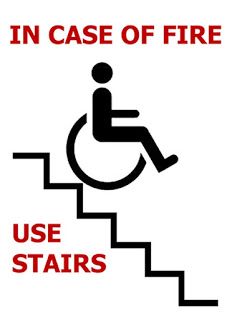This Shocktober we’re on a mission to provide CPR & AED awareness training to as many people as we can. 3 Steps for Life is free training designed to give you the confidence to take action if someone suffers a cardiac arrest. Join us for a session in your community.
When Accessibility is Just a Facade
Despite New Zealand’s legal commitments, genuine accessibility remains inconsistent and overlooked. This op-ed highlights the gap between policy and practice — revealing how disabled people continue to face barriers in spaces that claim to be inclusive. It’s a call for accountability, clarity, and change.
When Accessibility is Just a Facade By Erica Tebbutt, Founder of HAIL
I didn’t expect that asking people to follow the law — laws designed to protect human rights — would leave
me feeling exposed, exhausted, and disheartened.
All I did was raise questions. About compliance. About accessibility. About whether we, as a country, are
truly upholding our obligations under the United Nations Convention on the Rights of Persons with
Disabilities (CRPD) — a treaty New Zealand ratified in 2008, committing to:
“Ensure to persons with disabilities access, on an equal basis with others, to the physical
environment, to transportation, to information and communications… and to other facilities and
services open or provided to the public.”
But what I received in return wasn’t reassurance or accountability — just silence, deflection, and resistance.
New Zealand was formally questioned by the UN for its continued reliance on vague clauses like “as nearly
as is reasonably practicable” — wording that allows developers, councils, and operators to sidestep full
accessibility while still claiming legal compliance. In practice, it creates loopholes that favour cost-saving
over inclusion.
We do have laws referencing accessibility — the Building Act 2004 and Clause D1 of the Building Code
require public buildings to provide “reasonable and adequate means of access.” But they don’t define
accessibility in human terms — only in technical minimums. The standard often cited, NZS 4121:2001, is
outdated and limited in scope, addressing mobility access but ignoring broader needs. There is no
meaningful enforcement unless someone complains. And even then, outcomes are slow, patchy, and
inconsistent.
This legal vagueness has created a façade: a world of “accessible” spaces that, in reality, exclude the very
people they claim to accommodate. A ramp without a mobility park. An “accessible” toilet with no
automated door. Buildings with multiple units — all accessible only by stairs.
Meanwhile, councils spend public funds on beautification projects: murals, plazas, “smart benches,” digital
kiosks. These trend-driven developments are marketed as community improvements, but are rarely built
with disabled citizens in mind. Accessibility is legally required. Art installations are not. Yet one receives
urgency and funding. The other receives delay, dispute, or deletion from the budget.
Worse still is the state of mobility parking — a daily battleground in plain sight. Most mobility spaces in
Aotearoa don’t meet national standards. Some are dangerously sloped or blocked. Others are poorly
marked or sit far from entrances. Abuse is widespread. Enforcement is weak. And the revenue from fines? It
vanishes into general council budgets — not ring-fenced for accessibility audits, upgrades, or community
consultation. We ticket people for breaking the rules, then fail to fix the broken systems those rules were
meant to support.
All of this points to one truth: accessibility is not treated as a right in New Zealand. It is treated as a
burden, a tick box, or a gesture — optional, flexible, and often ignored altogether.
1
This has taken a personal toll. There have been moments where I’ve felt defeated — not because I doubt
the cause, but because I’ve seen how deeply ingrained the resistance is. The burden shouldn’t fall on
disabled people or those who advocate for them to prove that access matters. Yet here we are — still
fighting to be seen, heard, and respected.
But I am not giving up.
Through HAIL, the platform I founded to advocate for those with high health needs and disability rights, I
will continue to investigate and expose the gap between what’s promised and what’s delivered. I will follow
the money. I will tell the stories. I will ask uncomfortable questions.
Because accessibility isn’t a point on a map. It’s a journey — one that must be unbroken, intentional, and
lawful. Anything less is not accessibility. It’s a façade.
And I won’t be silent about it.
About the author:
Erica Tebbutt is the founder of HAIL, an independent platform focused on equity, accessibility, and support for
families with high health needs in Aotearoa.

Article type:
Contact Name: Erica
Contact Phone: 0278346302
Contact Email: [email protected]